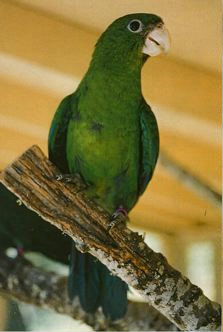|
|
|||||||||
|
On March 22, 1992 the first egg was discovered. Not knowing what kind of parents these birds would prove to be, it was decided to pull the eggs for artificial incubation and hand feeding. Five days after the first egg was laid, the hen laid another, and then again every two to three days after that until she had laid a total of eight eggs. The second hen began to lay seventeen days after the first hen. She basically followed the same pattern as the first, laying every two to three days until she had laid a total of seven eggs. Pulling the eggs was not difficult because the hens, while on the nest, are not overly protective, aggressive or frightened. The hens were never observed outside the nest box after they started to lay, and they remained in the nest for a period of five to seven days after the last eggs were pulled. The eggs were elliptical in shape, white with a dull finish and measured an average of 1.19 inches in length. Of the eight eggs laid by the first hen all were fertile, but of the seven that were laid by the second hen only the first two were fertile.
The eggs were incubated in a Peterzime incubator, model 1-MO4, at 99.1 degrees, with a 50% humidity. After 25 days of incubation, the first egg hatched on April 17th, 1992 (timed perfectly to coincide with their owner, Richard’s birthday)! Out of the ten fertile eggs, seven were successfully hatched. From day one the chicks were fed a commercial hand feeding formula. The babies grew quickly, and by the fourteenth day gray downy feathers had begun to replace the pure white down that the chicks were hatched with. Their eyes began to open at about twenty-one days and pin-feathers started to appear during their fourth week. It was during this period of weaning that two chicks died due to a respiratory disorder. |
|||||||||
|
|
|||||||||



